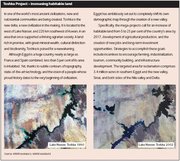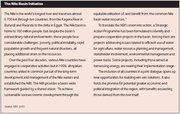Northern Africa and freshwater resources
Contents
Introduction Mean annual precipitation in Northern Africa. (Source: CEDARE (Northern Africa and freshwater resources) 2005; UNEP-GRID)
Northern Africa has a number of large water basins that are shared among several countries. These include surface and groundwater bodies. The Nile basin is its most important transboundary water basin. Groundwater aquifers, such as the Nubian Sandstone Aquifer, which are mostly non-renewable and transboundary in nature, play a vital role in meeting basic water needs.
Northern Africa is Africa’s driest sub-region and is characterized by limited water resources. The harsh conditions in the Sahara Desert have forced the majority of the people to live along the Mediterranean coast and the Nile. The region lies in the arid or semiarid climate zones, where dry conditions prevail all over, except for a narrow strip along the northern coast of the Mediterranean. Annual rainfall is highest along the north coast, and decreases southwards. It ranges from less than 50 millimeters (mm) in the southern parts (deserts) to 1,000 mm in few parts of the extreme north-western parts.
Endowment and opportunities
The Nile supports a range of ecosystems, such as the highly productive Sudd wetlands in southern Sudan. These wetlands and the Nile delta sustain important fish, mammal and bird species. The 20,000 km2 Nile delta in Egypt includes lakes, freshwater and saline wetlands, and intertidal areas, as well as large agricultural areas and towns. The wetlands play an important role in flood retention and release, maintaining flows in the Nile system and thereby supporting vulnerable communities long after the rains have passed.
Inland waters, not associated with the Nile, depend mainly upon drainage from the Atlas Mountains. These rivers are intermittent, with a discharge either to the coast or to the interior into salt pans or sand dunes. In the desert areas, the inland waters manifest as oases, which are crucial life-support systems to nomadic peoples.
 Libya's Great Human-Made River Project. (Source: NBI 2001)
Libya's Great Human-Made River Project. (Source: NBI 2001) Various options for transboundary water sharing have been studied to achieve a more balanced distribution of the available water resources in the region. From a technical point of view, Congo River water could be transferred via its tributary (the Ubangui River) to the north to supply Lake Chad and the northern African countries via the Al-Kufra basin. Being primarily agricultural economies, the agricultural sector requires the most water. The gap between water needs and available resources is narrowed in several ways. In Egypt, for example, where demand is met through the re-use of irrigation and treated water, two non-conventional options that are being implemented are water harvesting for agriculture in the Sinai and desalination of seawater in [[coast]al areas].
Libya has adopted a different approach and aims at meeting urgent water needs through its Great Man-Made River (GMMR) project by tapping non-renewable resources.
 Toshka Project-Increasing habitable land. (Source: MWRI)
Toshka Project-Increasing habitable land. (Source: MWRI) Water use is expected to increase with expansion in previously uninhabited land. The area of the Nile valley and its delta represents about 4 percent of the area of Egypt. With the increase in population, at a somewhat decreasing rate of growth of 2.6 percent, the Egyptian government has realized the necessity of accelerating its horizontal expansion plans into the deserted and uninhabited regions of Egypt. As part of this expansion plan, agricultural land will expand by an area of just over 1.4 million hectares (ha) in several regions of Egypt, by the year 2017. The Southern Egypt Development Project (Toshka Project) represents 226,800 ha of the total planned agricultural expansion.
The gap between water needs and available resources is narrowed in several ways. Water recycling and water harvesting are options that could be built upon for increasing water availability. In the agricultural sector, modifying cropping patterns and selecting crops using less water will reduce water use.
Challenges faced in realizing opportunities
Northern Africa is the most water-stressed sub-region and freshwater availability will become an even more important issue in the coming decades. Increasing water scarcity may lead to water-related conflicts. For the western Maghreb countries (Morocco, Algeria and Tunisia), climate change scenarios predict a rise in temperature of between 2° and 4°C this century, accompanied by a reduction in rainfall of up to 20 percent and increased evapotranspiration. This would result in decreased soil moisture and reduced surface and groundwater resources.
Salinization of soils, which threatens food production, is already a concern in irrigated areas, especially along the Nile, and may worsen. Similarly, as a result of land degradation (Land degradation and desertification in Africa) due to agriculture and livestock grazing, soil erosion is causing sedimentation impacts downstream. Erosion in the Nile delta has increased since the 1960s when completion of the Aswan High Dam stopped the annual flood with its replenishing sediment.
Another concern is seawater intrusion resulting from overexploitation of groundwater resources in [[coast]al areas], where the main urban centers are located. The Nile basin’s most polluted wetlands are in the Nile delta, where irrigation drainage water, untreated or partially-treated urban wastes and industrial effluents have destroyed several forms of aquatic life, reduced the productivity of the fisheries and contaminated the fish catch. Throughout North Africa, pollution due to urban wastes and agriculture are causing water quality degradation.
Strategeis to improve opportunities
 The Nile Basin Initiative. (Source: NBI 2001)
The Nile Basin Initiative. (Source: NBI 2001) Improved institutional and governance frameworks may increase the potential to improve opportunities. Egypt and Sudan have reformed their legal systems to protect water resources from pollution and misuse. At institutional level, both countries have decentralized water resource management and established institutions to support the participation of stakeholders in decision-making processes. Transboundary cooperation on water matters takes place within the framework of the Nile Basin Initiative. For all sectors, water demand can be reduced by introducing participatory management approaches and applying key principles, such as the polluter pays principle. Measures are also taken for the protection of water resources and these include the establishment of monitoring networks with water quality indicators and the enforcement of laws.
 The Egypt-West Beheira underground irrigation system construction site. (Source: U. Wieland/IFAD)
The Egypt-West Beheira underground irrigation system construction site. (Source: U. Wieland/IFAD) Across the Maghreb in the northwest, awareness has been raised about the consequences of climate change for agriculture and [[coast]al zones], and the communities who are dependent on them for their livelihoods. This has resulted in the political will to address the issues at regional level and in the development of a three-year vulnerability and adaptation project for the region (the Projet Maghrébin sur les Changements Climatiques). The project aims to achieve:
- A regionally integrated adaptation network, capable of continuing policy development, information exchange, vulnerability monitoring and project identification;
- Strengthened national capacities to respond to climate change;
- Development of national adaptation plans; and
- Deepened public awareness of the risks of climate change and the opportunities of carefully considered options.
Capacity-building is recognized as a basic requirement for water resource development. For this reason, training centers for water professionals have been set up in Egypt and Sudan. Professionals from other African countries are also being trained here. In the Maghreb, capacity exists within “Centres of Excellence” that, if suitably strengthened, would be capable of assuming leadership in the development of a planning framework to identify, assess and implement adaptation strategies in the near future.
Over the past few years, data collection systems have been improved. In Egypt, for example, a countrywide telemetry system was established for measuring water levels in canals. Databases were also built and data formats standardized to facilitate exchange of information. Egypt and Sudan have embarked on cost-recovery approaches for the industrial and domestic sectors. Irrigation water, however, has been provided free of charge to farmers and, consequently, no conservation measures were taken.
Among the strategic options is private sector participation. Investors have been encouraged to own and cultivate new land using modern irrigation systems, such as sprinklers and drip irrigation. In addition, donors financially and technically assist in improving the legal and institutional arrangements in the water sector, developing water resource plans and transferring knowledge and technology.
Further Reading
- IPCC, 2001. Climate Change 2001: Synthesis Report. A Contribution of Working Groups I, II, and III to the Third Assessment Report of the Intergovernmental Panel on Climate Change (eds. Watson, R.T. and the Core Writing Team). Cambridge University Press, Cambridge. ISBN: 0521807700
- NEPAD, 2003. Action Plan for the Environment Initiative. New Partnership for Africa’s Development, Midrand.
- NBI, GEF, UNDP and World Bank, 2001. Nile River Basin: Transboundary Environmental Analysis. Working Paper No. 24942. Nile Basin Initiative, Global Environment Facility, United Nations Development Programme and World Bank.
- Zalla, T., Fawzy, M.A., Saad, A.Y., Ishak, Y., Riad, M. and El Noubi, H.M., 2000. Availability and Quality of Agricultural Data for the New Lands in Egypt. Impact Assessment Report No. 12. Abt Associates Inc., Cairo.
|
|
| Disclaimer: This article is taken wholly from, or contains information that was originally published by, the United Nations Environment Programme. Topic editors and authors for the Encyclopedia of Earth may have edited its content or added new information. The use of information from the United Nations Environment Programme should not be construed as support for or endorsement by that organization for any new information added by EoE personnel, or for any editing of the original content. |